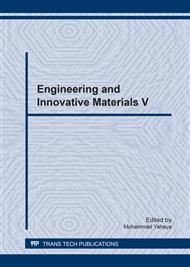p.14
p.19
p.25
p.30
p.36
p.45
p.51
p.56
p.65
Failure Analysis of Glass/Epoxy and Graphite/Epoxy Laminates due to the Effect of Variation in Lamination Scheme and Angle of Fibre Orientation
Abstract:
Understanding the failure behaviour of composite laminate is crucial in designing a reliable composite structure. Failure analyses have been carried out widely. Nevertheless, the composite laminate displacements before the occurrence of failure have not been analysed thoroughly, especially when comparing between Glass/Epoxy and Graphite/Epoxy, which are the two most common composite laminates. For example, it could be observed that the lamination schemes and variations of angle orientation could affect the displacements and failure behaviour of the symmetric laminate. Therefore, this paper aims to investigate the effect of lamination scheme and angle variations to the displacements and failure behaviour of two most common composite laminates, which are Glass/Epoxy and Graphite/Epoxy laminates. Finite element modelling and analysis of symmetric Glass/Epoxy and Graphite/Epoxy laminates with various angles of fibre orientation subjected to uniaxial tension are performed. Maximum Stress Theory and Tsai-Wu Failure Criteria are employed to determine the failure load. Prior to that, convergence analysis and numerical validation are carried out. Displacements and failure behaviour of the Glass/Epoxy and Graphite/Epoxy laminates (symmetric) are analysed. The failure curves (FPF and LPF) for both theories (Maximum Stress Theory and Tsai-Wu) are plotted and found to be very close to each other. Therefore, it can be concluded that the current study is useful and significant in enhancing knowledge about the failure behaviour, deformation behaviour and mode of failure of composite laminate.
Info:
Periodical:
Pages:
36-44
Citation:
Online since:
March 2017
Authors:
Price:
Сopyright:
© 2017 Trans Tech Publications Ltd. All Rights Reserved
Share:
Citation:


